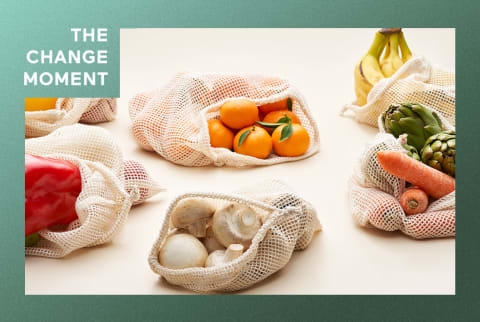Advertisement
What A Bike Trip Taught Me About The Food Waste Crisis + How To Get Involved


When I was 27, I spent eight months biking across Asia. Exhausted near the end of my trip, I stopped to recharge and volunteer for about six weeks in a subsistence farming community in the Indian Himalayas.
The people who lived there mostly grew their own food and traded for what else they needed, so they had previously had no need for money. But when rice—which couldn't grow locally—was introduced, community members needed to earn cash to buy it.
This completely transformed their lifestyles. Instead of farming his own food, the father of the family I was staying with became a teacher to make money, and the children were sent away to school in a town several hours away so that they, too, could someday earn a living. During my time in this community, I realized how food is absolutely fundamental to the way our lives are crafted and that food is at the center of so many things I love and care about—health, resource use, justice, and our sense of community.
How this experience opened my eyes to the threat of food waste.
I returned from the trip knowing that I wanted to be a part of that field, and while working on a sustainable agriculture project for the Natural Resources Defense Council (NRDC), I was put in charge of learning more about waste on farms.
It was at that point that I discovered the degree to which food is wasted in this country and around the world. I couldn't believe no one was talking about it! I would go to the farmers and food companies I was working with and say, "This report says approximately 40% of U.S. food is going to waste1, and 25% of our water is going to grow it—could that possibly be true?" They would think for a moment, nod, and say, "Yeah, that sounds about right." But they didn't seem to think that was a problem. This lit a fire under me. There we were, trying to get farmers to be 5 to 10% more efficient with their water, but we weren't even using more than a third of the food in the end. It was like energy efficiency but for the food sector—except no one was even talking about it, let alone doing anything.
I began researching incessantly and ultimately published a report called Wasted: How America Is Losing Up to 40% of Its Food From Farm to Fork to Landfill, which was released by NRDC in 2012. It made breaking news headlines and lit a fire under others as well. From then on, it was like drinking from a firehose, as so many people were interested in taking on food waste. I spent the rest of my time at NRDC focused exclusively on the issue, including testifying before Congress on the topic and partnering with the Ad Council to develop the "Save The Food" campaign, which helps consumers address waste in their own kitchens.
In 2015, a dedicated group of researchers, academics, and investors wrote a new report called the Roadmap To Reduce U.S. Food Waste by 20 Percent. It was the first national action plan to reduce food waste, and it went beyond just explaining the environmental, social, and economic impacts of food waste to providing actual solutions to fight it and showing what the benefits would be when we did. When it was released in 2016, the response was immediate. Nobody had seen the case for fighting food waste laid out like this before. That report turned into what is now the national nonprofit ReFED, which advances data-driven solutions to end food loss and waste and which I am fortunate enough to lead.
The top ways to waste at home.
One of ReFED's main messages is that food waste is a systemwide problem, so it will take a systemwide effort to fight it. There are, however, plenty of ways for individuals to get involved from their own kitchens. Here are five of my top tips:
Plan ahead.
Don't buy groceries without thinking ahead a few days or a week to consider what you'll be eating. That way, you'll only buy what you need! If you're going to eat frozen pizza or go out for a meal with your friends or family, plan for that too so you don't buy anything else for that night and end up not eating it.
Store your food properly.
Different foods need to be stored differently, and they'll last a lot longer when they are stored in the right way.
Use your freezer.
I like to think of the freezer as a magic "pause" button to keep food fresh longer. You can freeze almost anything, cooked and uncooked. Just check online to see which is best for the foods you're freezing. An added benefit is when you don't feel like cooking, you can just take something out of the freezer to heat up and eat.
Learn your labels.
Date labels typically refer to quality, not safety! Major food industry groups have endorsed the use of "use by" to indicate when a product should be discarded for food safety reasons. So use your best judgment—if a product looks good, smells good, and tastes good, it's probably OK to consume.
Eat down.
As you're planning ahead for what you'll be eating for the week, plan in a day to "eat down" all of the leftovers and excess food in your fridge. Separately, they might not be enough for a full meal, but together, they're just right.
The takeaway.
As I learned in the Indian Himalayas all those years ago, food has the power to transform communities—and it's wrong to waste it. It's time to create a sustainable, inclusive, and resilient food system that makes the best use of the food we grow. And we can all help support it from our kitchens.